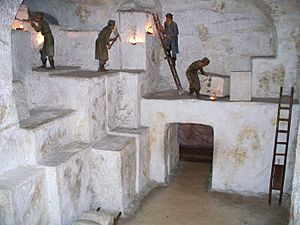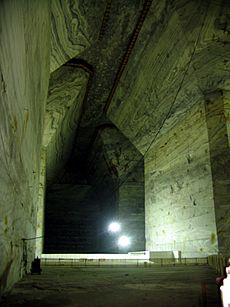Salt mining facts for kids
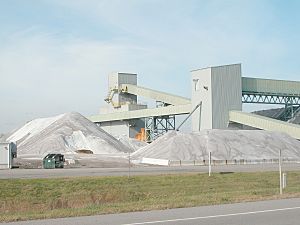
Salt mining is how people dig up natural salt from deep underground. This salt is usually called halite, or rock salt. It comes from special rock layers called evaporite formations.
Contents
A Look at Salt Mining History
For a long time, getting salt from mines was very hard and dangerous. Miners could get very dehydrated from the salt dust in the air. Before modern machines, salt was rare and valuable. Often, people who were enslaved or prisoners had to do this work. Their lives were often short.
Ancient Salt Mining in China
Ancient China was one of the first places to mine and trade salt. They even found natural gas while digging for rock salt! A Chinese writer named Zhang Hua wrote about people in Zigong, Sichuan. They used natural gas to boil salt water.
The Chinese got better at mining salt over time. It was still tough because of the land and technology. Most of their salt came from the sea. They used natural crystallization in salt lakes. They also built basins near the coast.
In 1041, during the Song dynasty, they drilled a salt well. It was very deep, like many dozens of feet. In other parts of China, they drilled over 1,000 meters deep for salt. Salt was very important for daily life. It also brought a lot of money to the Chinese government.
Modern Salt Mining Today
Today, salt is easy to find. Most modern salt mines are run by private companies. Big companies like K+S, AkzoNobel, Cargill, and Compass Minerals operate them.
Where Salt is Mined Around the World

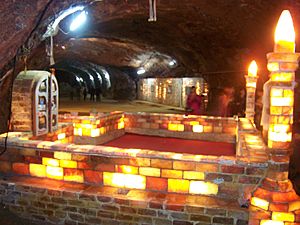
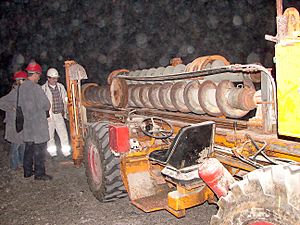
Many countries have important salt mines. Here are some of them:
| Country | Site(s) |
|---|---|
| Austria | Hallstatt and Salzkammergut. |
| Bosnia and Herzegovina | Tuzla. |
| Bulgaria | Provadiya; and Solnitsata. This ancient town might be Europe's oldest. It was a salt-making place about six thousand years ago. |
| Canada | Sifto Salt Mine in Goderich, Ontario. It is one of the biggest salt mines in the world. It is about 1.5 miles (2.4 km) wide and 2 miles (3.2 km) long. It covers about 7 square kilometers. |
| Colombia | Zipaquirá. |
| England | The "-wich towns" of Cheshire and Worcestershire. |
| Ethiopia, Eritrea, Djibouti | Danakil Desert. Here, people still dig for salt by hand. |
| Germany | Rheinberg, Berchtesgaden, Heilbronn. |
| Republic of Ireland | Mountcharles. |
| Italy | Racalmuto, Realmonte and Petralia Soprana. These are managed by Italkali. |
| Morocco | Société de Sel de Mohammedia (Mohammedia Rock Salt company) near Casablanca. |
| Northern Ireland | Kilroot, near Carrickfergus. This mine is over 100 years old. Its passages are more than 25 km long. |
| Pakistan | Khewra Salt Mines. This is the world's second-largest salt mine. It stretches over 300 km. Alexander the Great's horse found it first. The mine is still working today. |
| Poland | Wieliczka and Bochnia. Both started in the mid-1200s. They still operate, mostly as museums. Also, Kłodawa Salt Mine. |
| Romania | Slănic (with Salina Veche, Europe's largest salt mine), Cacica, Ocnele Mari, Salina Turda, Târgu Ocna, Ocna Sibiului, Praid and Salina Ocna Dej. |
| Russia |
|
| Ukraine | Soledar Salt Mine in Soledar, Donetsk oblast. |
| United States |
|
"Back to the Salt Mines"
Sometimes, people say "back to the salt mines." This is a funny way to talk about going back to work. It can also mean going back to a boring task. This saying started around the 1800s. It referred to Russia sending prisoners to work in harsh Siberian salt mines.
See also
 In Spanish: Mina de sal para niños
In Spanish: Mina de sal para niños
- Salt mines
- Khewra
- Schacht Asse II
- Turda
- Wieliczka
- Windsor
- General
- Salt evaporation pond
- Brine mining
- Injection well
- Salt lake
- Salt dome
- Miner


